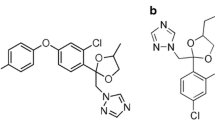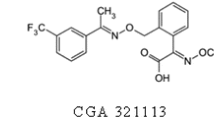Abstract
Carbendazim is widely used on pomegranate for control of a large number of fungal diseases. Its residue levels in/on pomegranate fruits and soil were evaluated under field conditions. The quick, easy, cheap, effective, rugged, and safe (QuEChERS) method in conjunction with liquid-chromatography mass spectrometry was used for analysis of carbendazim. Recovery of carbendazim was within 78.92–96.28 % and relative standard deviation within 3.8–10.9 % (n = 6). Carbendazim residues on pomegranate fruits dissipated at the half lives of 17.3 and 22.8 days from treatments at 500 and 1000 g active ingredient (a.i.) ha−1, respectively. Its residues in pomegranate aril were highest on the tenth day and reduced thereafter. The residue level of carbendazim on pomegranate whole fruits from standard dose treatment was less than the EU maximum residue limit (MRL) of 0.1 mg kg−1 at harvest. The carbendazim residues were <LOQ in the aril and field soil at harvest. The pre-harvest intervals (PHIs) of carbendazim on pomegranate were 65.4 and 103.4 days. The results of this study can be used to determine the judicious use of carbendazim for plant protection of pomegranate crop.




Similar content being viewed by others
References
Anastassiades, M., Lehotay, S. J., Stajnbaher, D., & Schenck, F. J. (2003). Fast and easy multiresidue method employing acetonitrile extraction/partitioning and dispersive solid-phase extraction for the determination of pesticide residues in produce. Journal of Association of Official Analytical Chemists, 86, 412–431.
Anonymous. (2007). Project report on export promotion of pomegranate from India by Agricultural Finance Corporation. New: Delhi.
Anonymous. (2008). MRLs of concern for the active substance carbendazim. European Food Safety standard Authority. EFSA Scientific Report, 158, 1–31.
Babu, K. D., Singh, N. V., Chandra, R., Sharma, J., Malty, A., & Sarkar, P. C. (2014). Effect of surface coating with lac based formulations on postharvest quality of pomegranate (Punka grantum L.) fruits. International Journal of Tropical Agriculture, 32, 835–839.
Bakirci, G. T., Acay, D. B. Y., Bakirci, F., & Otles, S. (2014). Pesticide residues in fruits and vegetables from the Aegean region, Turkey. Food Chemistry, 160, 379–392.
Bhatt, H. R., & Jadeja, K. B. (2010). Mango stem end rot management with carbendazim. Indian Phytopathology, 63(1), 103–105.
Cabras, P., Melis, M., Cabitza, F., Cubeddu, M., & Spanedda, L. (1995). Persistence of pirimicarb in peaches and nectarines. Journal of Agricultural and Food Chemistry, 43, 2279–2282.
Devarajan, L., Chinniah, C., Jayakumar, R., & Mani, S. (2000). Evaluation of carbendazim residues from post-harvest treatment of ripening mango fruits. Madras Agricultural Journal, 87, 672–673.
Dubey, J. K., Sharma, V. P., Patyal, S. K., & Nath, A. (1994). Persistence of carbendazim on white button mushroom, Agaricus bisporus. Mushroom Research, 3, 81–82.
Gupta, V. K., & Sharma, S. D. (1989). Degradation of carbendazim in soil by microorganisms. Indian Journal of Agricultural Sciences, 5, 21–24.
Gurbuz, N., Ari̇k, O., & Baykal, A. (2014). Screening of pesticide residues in fresh vegetables and fruits by LC-MS/MS and GC-MS/MS. Asian Journal of Chemistry, 26, 6975–6981.
Harzallah, A., Hammami, M., Kepczynska, M. A., Hislop, D. C., Arch, J. R. S., Cawthorne, M. A., & Zaibi, M. S. (2016). Comparison of potential preventive effects of pomegranate flower, peel and seed oil on insulin resistance and inflammation in high-fat and high-sucrose diet-induced obesity mice model. Archives of Physiology and Biochemistry, 122, 75–87.
Hoskins, W. M. (1961). Mathematical treatment of the rate of loss of pesticide residues. FAO Plant Protection Bulletin, 9, 163–168.
Indra, N. (2013). Prevalence of sapota leaf spot disease (Phaeopleospora indica) and its management with fungicides in Tamil Nadu. Journal of Mycology and Plant Pathology, 43(4), 419–422.
Jamadar, M. M., Sataraddi, A. R., Patil, P. V., Jawadagi, R. S., Patil, D. R., Sheikh, M. K., Mokashi, A. N., & Rokhade, A. K. (2011). Status of pomegranate diseases of northern Karnataka in India. Acta Horticulturae, 890, 501–507.
Janaki, R. S., Priya, C., & Chinnusamy, C. (2013). Field dissipation of oxyfluorfen in onion and its dynamics in soil under Indian tropical conditions. Journal of Environmental Science and Health Part B, 48, 941–947.
Jatav, N. K., Rana, R. S., Verma, J. R., & Verma, S. K. B. (2014). Chemical control of dry bubble disease induced by Verticillium fungicola [Preuss] Hassebr on white button mushroom, Agaricus bisporous. African Journal of Microbiology Research, 8, 2202–2207.
Juraske, R., Fantke, P., Ramírez, A. C. R., & González, A. (2012). Pesticide residue dynamics in passion fruits: comparing field trial and modelling results. Chemosphere, 89, 850–855.
Khosla, K., Bhardwaj, S. S., & Kumar, J. (2008). Field evaluation of fungicides against fruit spot and rot diseases of pomegranate. Haryana Journal of Horticultural Sciences, 37, 22–24.
Kjindal, K., Sharma, R. C., & Gupta, V. K. (1989). Chemical control of bacterial leaf spot and fruit gummosis caused by Xanthomonas campestris pv. pruni in almond (Prunus dulcis). Indian Journal of Agricultural Sciences, 59(11), 754–755.
Kumar, J., Watpade, S., Pramanick, K. K., Shukla, A. K., & Kumar, J. (2015). Evaluation of some fungicides for control of smoky blight canker in apple (Malus × domestica). International Journal of Tropical Agriculture, 33(2), 1549–1551.
Leroux, P., Casanova, M., & Dachaud, R. (1975). A study of the penetration and persistence of benomyl and carbendazim in apples treated after harvest. Phytiatrie-Phytopharmacie, 24, 49–56.
Mohapatra, S. (2014). Residue dynamics of chlorpyrifos and cypermethrin in/on pomegranate (Punica granatum L.) fruits and soil. International Journal of Environmental Analytical Chemistry, 94(14-15), 1394–1406.
Mohapatra, S. (2015). Dynamics of difenoconazole and propiconazole residues on pomegranate over 2 years under field conditions. Environmental Science and Pollution Research, 23, 5795–5806.
Moody, R. P., Prasad, R., Greenhalgh, R., Weinberger, P., Roberts, J. R., Greenhalgh, R., & Marshall, W. K. (1977). Translocation of ring labelled 14C-fenitrothion in conifers (pp. 217–231). National Research Council Canada: Report.
Mousa, M., Sagar, V. R., Gajbhiye, V. T., & Kumar, R. (2004). Pesticides persistence in/on fresh and dehydrated brinjal. Journal of Food Science and Technology (Mysore), 41, 429–431.
Nargund, V. B., Jayalakshmi, K., Benagi, V. I., Byadgi, A. S., Patil, R. V., Melgarejo, P., & Valero, D. (2012). Status and management of anthracnose of pomegranate in Karnataka State of India. Options Mediterraneennes. Serie A Seminaires Mediterraneens, 103, 117–120.
Navale, M., Suryawanshi, K. T., & Waskar, D. P. (2010). Response of Bhagwa variety of pomegranate to post-harvest treatments for extending the shelf life under different storage conditions. Annals of Plant Physiology, 24(1), 77–81.
Paszko, T. (2012). Effect of pH on the adsorption of carbendazim in Polish mineral soils. Science of the Total Environment, 435, 222–229.
Patel, D. S. (2009). Chemical management of fruit spot of pomegranate caused by Colletotrichum gloeosporioides Penz. and Sacc. Indian Phytopathology, 62(2), 252–253.
Petrucci, R. H. (2007). General chemistry: principles and modern applications (9th ed.). New Jersey: Pearson Education Inc.
Rinaldi, M., Caligiani, A., Borgese, R., Palla, G., Barbanti, D., & Massini, R. (2013). The effect of fruit processing and enzymatic treatments on pomegranate juice composition, antioxidant activity and polyphenols content. Food Science and Technology, 53, 355–359.
Sadlo, S. (2001). Disappearance of dichlofluanid, chlorothalonil, vinclozolin and carbendazim on greenhouse tomatoes. Journal of Plant Protection Research, 41, 5–11.
SANCO (2013). Guidance document on analytical quality control and validation procedures for pesticide residues analysis in food and feed. SANCO/12571/2013.
Sarkale, V. M., Sanghavi, K. U., Dhemre, J. K., & Masalkar, S. D. (2003). Effect of post-harvest treatments on shelf-life and quality of pomegranate in cold storage and ambient conditions. Journal of Food Science and Technology (Mysore), 40(1), 67–69.
Sharma, S. K., & Bharat, N. K. (1994). Persistence of carbendazim on apple fruit and leaves. Plant Disease Research, 9, 204–206.
Sharma, K. K., Mohapatra, S., Ahuja, A. K., Deepa, M., Sharma, D., Jagdish, G. K., Rashmi, N., Battu, R. S., Sharma, S. K., Singh, B., Parihar, N. S., Sharma, B. N., Kale, V. D., Nakat, R. V., Walnuj, A. R., Singh, G., Kuldeep, K., Ravivanshi, Devi, S., & Noniwal, R. (2014). Safety evaluation of flubendiamide and its metabolites on cabbage and persistence in soil in different agroclimatic zones of India. Environmental Monitoring and Assessment, 186, 3633–3639.
Siddamallaiah, L., & Mohapatra, S. (2016). Residue level and dissipation pattern of spiromesifen in cabbage and soil from 2-year field study. Environmental Monitoring and Assessment, 188, 155.
Singh, J., & Majumdar, V. L. (2002). Fungicidal management of Alternaria rot in pomegranate. Journal of Mycology and Plant Pathology, 32(1), 134.
Tomlin, C. (1994). The pesticide manual (10th ed., pp. 149–150). U.K.: British Crop Protection Council and Royal Society of Chemistry.
Utture, S. C., Banerjee, K., Dasgupta, S., Pati, S. H., Jadhav, M. R., Wagh, S. S., Kolekar, S. S., Anuse, M. A., & Adsule, P. G. (2011). Dissipation and distribution behavior of azoxystrobin, carbendazim, and difenoconazole in pomegranate fruits. Journal of Agriculture and Food Chemistry, 59, 7866–7873.
Wang, Y., Li, S. H., Zhang, F. F., Lu, Y. F., Yang, B. C., Zhang, F., & Liang, X. M. (2016). Study of matrix effects for liquid chromatography-electrospray ionization tandem mass spectrometric analysis of 4 aminoglycosides residues in milk. Journal of Chromatography A, 1437, 8–14.
Yarita, T., Aoyagi, Y., & Otake, T. (2015). Evaluation of the impact of matrix effect on quantification of pesticides in foods by gas chromatography-mass spectrometry using isotope-labeled internal standards. Journal of Chromatography A, 1396, 109–116.
Acknowledgments
The author thanks the Director of the Indian Institute of Horticultural Research, Bangalore, India for providing the facilities to carry out the work for this study.
Author information
Authors and Affiliations
Corresponding author
Rights and permissions
About this article
Cite this article
Mohapatra, S., S., L. Residue level and dissipation of carbendazim in/on pomegranate fruits and soil. Environ Monit Assess 188, 406 (2016). https://doi.org/10.1007/s10661-016-5404-2
Received:
Accepted:
Published:
DOI: https://doi.org/10.1007/s10661-016-5404-2




